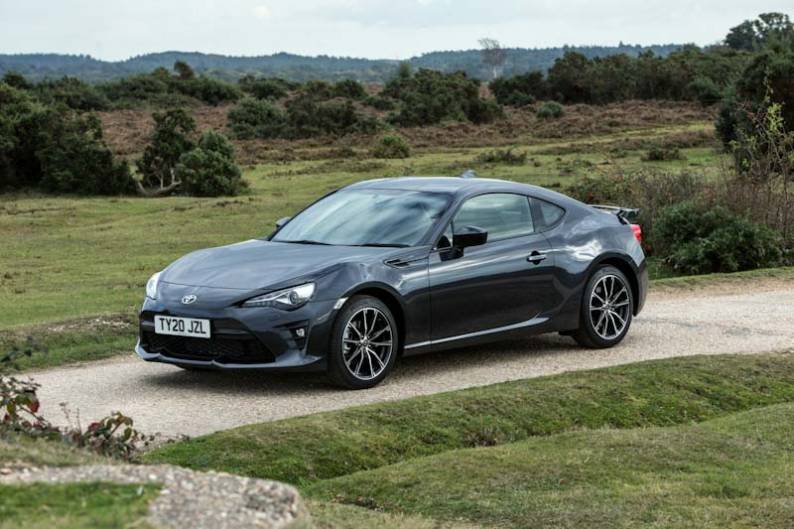
RAC sale – up to 33% off*
• Roadside cover from £5.29 a month†
• We get to most breakdowns in 60 mins or less
• Our patrols fix 4/5 breakdowns on the spot

By Jonathan Crouch
Introduction
If you thought involving affordable sportscars belonged back in history, then you'll find Toyota's GT86 a welcome breath of fresh air. The car was first launched in 2013, but we'd suggest you try and stretch to the facelifted version we examine here, introduced in 2016. This facelifted model wasn't any faster than the original but the suspension was stiffer, the steering was sharper and the car was made a little smarter, both inside and out. Otherwise, things were as before. Developed and desired by enthusiasts, the GT86 remains a benchmark in the compact coupe sector from its era, a master class in driving dynamics.
Models
3 dr Coupe [2.0] - (standard, PrO, CLUB SERIES BLUE EDITION, ORANGE EDITION)
History
They knew what sportscars were back in the Fifties. Not a lot of power. Not a lot of grip. And an awful lot of fun. If you see that as the classic automotive era, then it may be that you're not completely up to date with the quality of performance machines you'll find in the time you live in. Some of them are supercars - but not all. Here, for example, is a classic-in-the-making you might very well be able to out on your own driveway. It's name? Toyota's GT86.
For too long, enthusiasts have believed what the car makers have told them. That they needed more power, more grip, more fancy intervening electronics. It all looked good on paper but was often curiously unsatisfying out on the road. Time to go back to basics - which is exactly what Toyota did with this car, the 'Hachiroku', which translates as 'Eight, Six' in Japanese.
Four factors governed its development: light weight, modest normally aspirated power, rear wheel drive and narrow tyres. Lap times are unimportant. What matters is driving enjoyment and you might have forgotten just how much of a heritage affordable Toyota sportscars have in providing that, from the tiny S800 of 1962 to the GT2000 late that decade, the Celica of the '70's and the mid-engined MR2 of the '80's and '90's. After that, Toyota didn't offer enthusiasts very much, until this GT86 came along in 2013. The car was facelifted in 2016 and it's that updated model we're looking at here which sold until late 2020.
What You Get
At first glance, you might wonder what all the fuss is about. The styling, which didn't change much with this revised model, is smart but hardly show-stopping, with classic front engine / rear drive proportions delivering a long bonnet and a rear-set cabin. It was all little changed from the prototype that preceded this GT86 model's original launch, the FT-86 show car that Toyota unveiled at the 2011 Geneva Motor Show twelve months before production started at Subaru's Gunma plant in Japan.
There, GT86 models rolled down the same production lines as their all-but-identical Subaru BRZ counterparts, the only real visual difference between the two cars being the trapezoidal front grille section on this Toyota model. That's part of a front end that featured a sharper look with this revised post-2016-era model, with smarter headlight units that created a stronger horizontal emphasis.
And inside? Well in this improved model, the instrument panel got a one-piece design with a black finish and slicker carbon-fibre-pattern detailing. It was all part of an enhanced cockpit that was revised to create what Toyota hoped was a more 'connected feel' between driver and car. Central to this is the smarter three-spoke steering wheel, the smallest yet designed for a production Toyota with a cross-section apparently precision-calculated to provide the best possible grip and feel.
A 4.2-inch TFT multi-information display was added as part of the revised model changes in the instrument binnacle's triple-dial arrangement, with a switchable menu that provides the usual journey distance and fuel economy information, plus more performance-focused data, such as power and torque curves, a stopwatch and a G-force monitor.
It's a 2+2, so you get tiny rear seats that motoring journalists without small children usually moan about but we find really useful, if only for slinging your jacket on to. And there's a reasonably-sized boot - or at least it is once you fold the back seats down to extend the standard 243-litre capacity to a space so usable that it'll accommodate a trolley jack and four replacement wheels and tyres. Ideal for trackday types then.
What You Pay
Please fill in the form here for an exact up-to-date information.
What to Look For
Most GT86 customers we surveyed absolutely loved their cars. It was hard to find too many complaints. One owner was disgruntled because the battery kept running down when he left the car standing for a few weeks. Another talked of minor niggles with fit of the interior panels and a seal on driver's door window. Otherwise, there's not much you'll need to worry about. Try and avoid models that have been thrashed about on track days - check the tyres with this in mind.
Look carefully for any accident damage - a potential issue as this sportscar will have been driven hard by most previous owners. Even if the car looks OK, it's worth getting an HPI check done to make sure that no horrors are lurking beneath the apparently pristine panel work. Other common issues include rust on the door pillars (which will be covered by the warranty), water in the rear lights and lumpy engine idling, which you should look out for on your test drive.
Replacement Parts
(approx based on a 2016 GT86) An air filter will be priced in the £6 to £7 bracket, an oil filter will sit in the £2 to £10 bracket and a water pump will be around £60. The front brake discs we came across sat in the £63 to £88 bracket, with pricier-branded discs costing around £100-£130. The rear brake discs we came across sat in the £50 to £80 bracket, with pricier-branded discs costing around £140. Brake pads are in the £32 to £84 bracket for a set; for rear pads, its in the £11 to £53 bracket. Wiper blades cost in the £5 to £10 bracket.
On the Road
On the move GT86 regulars will in this revised post-2016-era updated model note the sharper steering and firmer suspension, plus the selectable 'Track' mode that was added, allowing the driver to better tap into the car's full potential by adjusting the level of stability and traction control. Otherwise, things are much as with the original version, so you get the same 197bhp 2.0-litre normally aspirated engine with a modest 205Nm torque figure necessitating frequent use of the slick-shifting 6-speed manual gearbox; a paddleshift auto was optional to new buyers - we'd avoid it.
You sit low down, grasping the smallest steering wheel Toyota fits to any production car, one positioned nicely upright, so you can flick easily through the corners from lock to lock without any trouble. We should also talk about traction and grip. There's not a lot - and you wouldn't expect there to be given that, quite intentionally, the engineers have specified this car to run on essentially the same skinny tyres as a feeble Toyota Prius. This won't do much for your lap times on a track day at Silverstone, but it's a brilliant recipe for fun on every deserted roundabout - especially in the wet, where power slides are yours for the asking. Brilliant.
Overall
Could this car be any better? Of course, it could be faster, grippier, quieter and of better quality inside. But we wouldn't really want it to be. All of those things would dilute the very qualities that make this GT86 what it is. Sportscars always used to be this way, light, low powered and modestly rubbered. We had fun in them then and we can have fun in this one now. The chassis is excellent, the controls are brilliant, the driving position nigh-on perfect and the engine, if not aurally exciting, is revvy and fun.
As for the changes made to this revised model, well, they were welcome but if you didn't like this car previously, they won't be enough to make you desire it any more. For the record though, when we tested this updated version, we liked the steering even more than we did before and felt that the cabin no longer looked and felt quite so low-rent, so that was progress of a sort.
Overall, what we have here is something to savour; one of those rare machines that involves you so much that you don't need to be travelling at three figure speeds to have fantastic fun. Factor in the affordable running costs and high residuals and this becomes a very tempting proposition indeed. In years to come, it'll be seen as a landmark car for Toyota.







